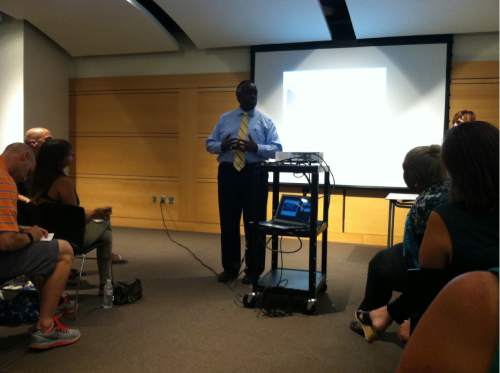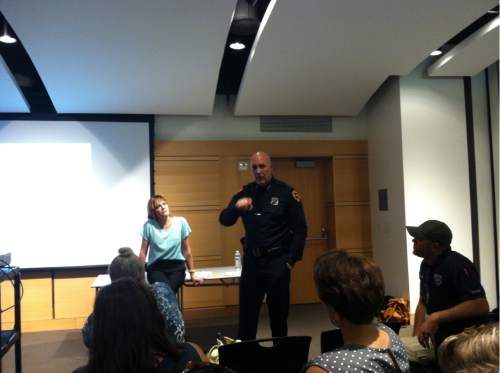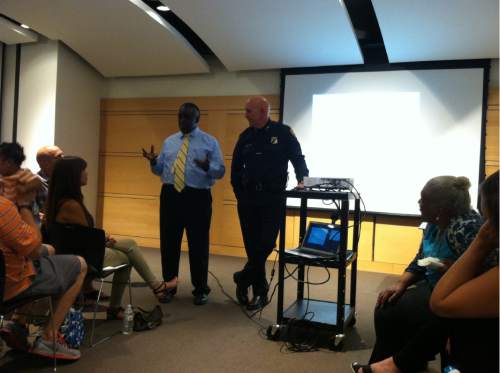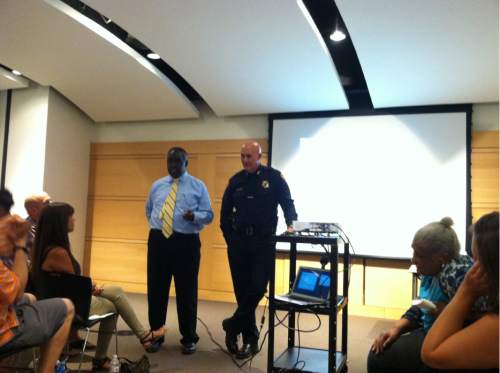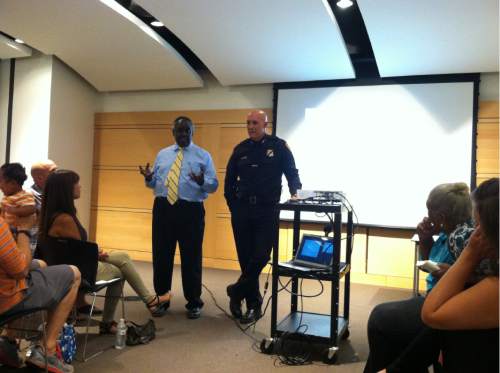This is an archived article that was published on sltrib.com in 2016, and information in the article may be outdated. It is provided only for personal research purposes and may not be reprinted.
Leah Steele Barnett is terrified for her son.
Steele Barnett wiped tears from her eyes with a matted tissue as she explained to Salt Lake City Police Chief Mike Brown that the reason for that fear is the color of her 10-year-old's skin.
"I am afraid that one time he might look too intimidating," she said with a shaky voice. "He has very dark skin."
Steele Barnett, a white woman, was one of about 30 attendees who spoke at a public meeting Tuesday night during which parents discussed their concerns for the interactions among their black children and police officers.
Following protests nationwide over the shootings of black men by police — most recently Alton Sterling in Louisiana and Philando Castile in Minnesota — the parents expressed collective fear for their children as two SLCPD officers and the chief listened, taking notes.
Dave and Carly Thompson, a white couple who adopted four children of color, brought their 6-month-old son to the meeting. The two were unsure what to tell their children about interacting with police and avoiding confrontations that may result from racial profiling.
"It just terrifies you that this might be one of your kids," Dave Thompson said about the fatal shootings at the hands of police.
The Salt Lake City Police Department Community Advisory Board hosted Tuesday's meeting at the Salt Lake Main Library downtown. David Parker, a black member of the board who moderated the event, said it was geared toward white parents because they may not have the "right tools" to talk their children of color about this topic.
"White parents are realizing more and more that the world treats their children of color differently," he said.
Midway through the meeting, Parker asked the audience who feared for a child because of race. Everyone in attendance silently and solemnly raised a hand. A few babies' coos and cries underscored their solidarity.
"We're here because there's a crisis," Parker said. "[We want] relationships that benefit our children."
Brown promised to put aside biases and work toward solutions within the department, including more de-escalation training. This kind of community conversation, rather than protests, he said, is beneficial. The discussion, he says, covered "blind spots" that may not be obvious to police and the community.
Brown suggested hosting a dinner during which children of color can interact with police officers to show them that there's nothing to fear.
"It breaks my heart that we're here," he said. "We'll keep meeting until we fix this problem."
Brown hugged several of the parents in the audience and called for action. He vowed that officers will look at the crime rather than the color of someone's skin.
"It should never be a race issue," he told Steele Barnett's husband, Sean Barnett.
Mason Givens, a black detective, said people can start by knowing their rights when police stop them. He advised residents to study search-and-seizure laws.
And officers, he said, should go through more extensive training on race: "We need to understand that more training is a good thing." About four of more than 400 officers working with Salt Lake police are black, Givens said; adding more diversity to the staff, he says, may also improve relations with the community.
Another crucial component is having children interact with police before they learn to fear them, Givens said. He says he's talked with kids around Salt Lake City since the 2014 fatal shooting of Michael Brown, a black man, by a white police officer in Ferguson, Mo.
Marci Phillips, a white mother of an 11-year-old black boy, said it's not that easy: She doesn't want her son to feel "too comfortable" around officers and let down his guard.
"If he screws up with the wrong person, he could be dead," she said while scrawling a long note on a comment card filled with concerns for police.
The police department will examine suggestions, Brown said, and may implement some. He wants Salt Lake City to serve as a model for Utah and the nation as to how officers and people of color can work together.
Anyone who wishes to comment on the topic to the community group can do so by emailing slcpdcommunityadvisoryboard@gmail.com.
ctanner@sltrib.com Twitter: @CourtneyLTanner


